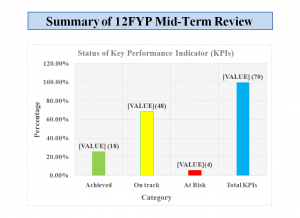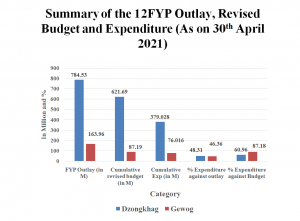The Government cannot continue to be a party to UNCAC until Legal Anomaly is resolved
- July 8th, 2022
- 1,387 views
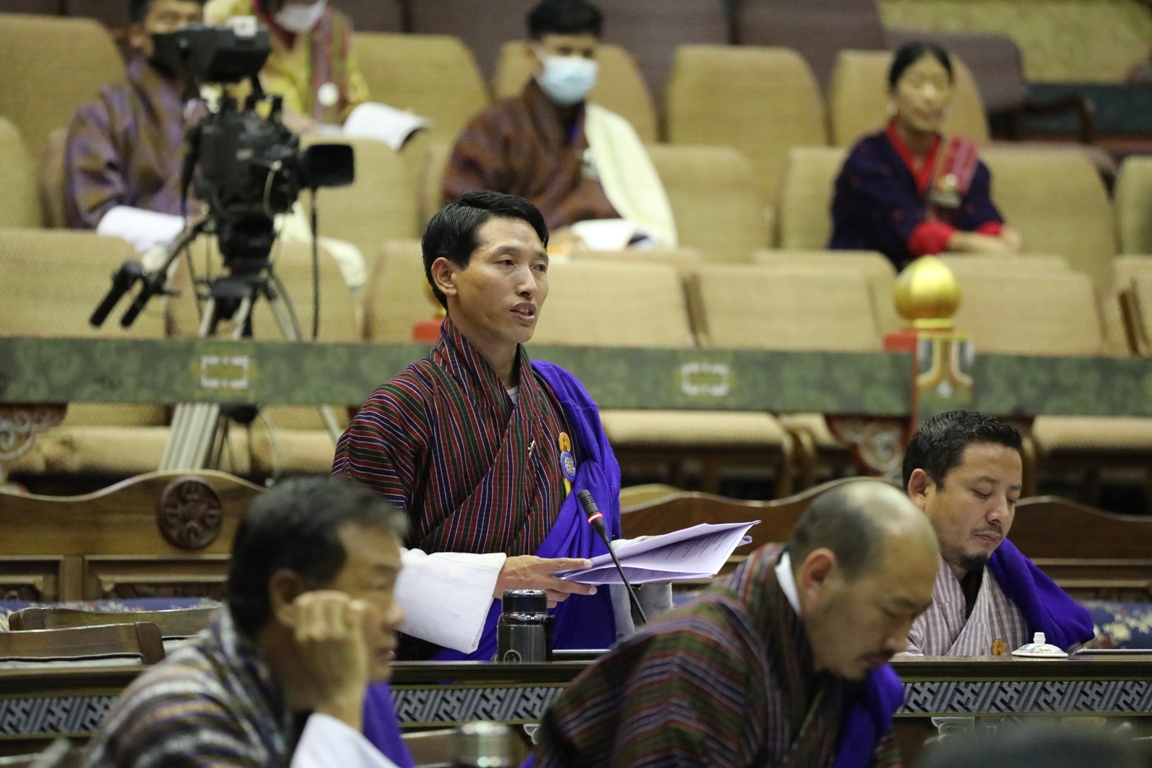
Context
The United Nations adopted the United Nations Convention Against Corruption (UNCAC) on 31st October 2003. UNCAC is the only globally binding legal instrument against Corruption. Bhutan became a signatory to the UNCAC in 2005. The two Houses of Parliament ratified the UNCAC with reservation to Paragraph 2 of Article 66 in 2015. On 26th May 2016, Royal Assent was granted to accede to the UNCAC, with reservation on Article 66 (2).
Article 66 (2) concerning dispute settlement states, “Any dispute between two or more States Parties concerning the interpretation or application of this Convention that cannot be settled through negotiation within a reasonable time shall, at the request of one of those States Parties, be submitted to arbitration. If, six months after the date of the request for arbitration, those States Parties are unable to agree on the organization of the arbitration, any one of those States Parties may refer the dispute to the International Court of Justice by request in accordance with the Statute of the Court.”
Subsequently, on 21st September 2016, the Minister of Foreign Affairs (MoFA), during the tenure of the Second Government, deposited the instrument of ratification with the Office of the Secretary-General of the United Nations. However, while depositing the instrument, the Ministry of Foreign Affairs failed to register the reservation. Following the lapses, MoFA requested the UNSG to accept the late registration of the reservation. In accordance with the depository practice, two member nations, namely Finland and the Netherlands, objected to the late registration of Bhutan’s reservation to Article 66 (2). Several unsuccessful attempts were made through bilateral arrangements to persuade the two nations to withdraw their objections.
Having failed to register the reservation, the Minister of Foreign Affairs tabled the amendment to UNCAC during the 5th Session of the Third Parliament to revoke the reservation to Article 66 (2). The National Assembly deliberated on the UNCAC (Amendment) and adopted the Convention by revoking the Parliament’s earlier reservation. The UNCAC (Amendment) was sent to the National Council for deliberation.
The National Council deliberated on the UNCAC (Amendment) Bill during its 28th Session. The House rejected the decision of the National Assembly to revoke the earlier reservation to Article 66 (2) and proposed to denounce and re-accede to the Convention with the reservation. The House also recommended that the Government fix accountability for the lapses.
During the re-deliberation of the UNCAC (Amendment) Bill, the National Assembly stood by its earlier decision and refused to accept the decision of the National Council.
Following the dispute between the two Houses, the Joint Committee on UNCAC (Amendment) was formed to discuss the Convention’s disputed clause.
The Joint Committee conducted several rounds of meetings, and after the review of all the documents submitted by the Ministry of Foreign Affairs and the Anti-Corruption Commission of Bhutan, the Joint Committee recommended:
- To denounce and re-accede to the Convention with reservation to Article 66 (2) of the UNCAC to safeguard the long-term national interest, uphold the rule of law, and protect the supremacy of Parliament.
- The Government to see where the lapses have occurred, fix accountability, and submit the action taken report to Parliament.
After a thorough deliberation in the House, the first recommendation of the Joint Committee was put to the vote by the Speaker. Out of 67 members present and voting, 33 voted in favor of the recommendation. While 30 members voted against the recommendation, another 4 members abstained.
As the first recommendation failed to obtain the required two-thirds majority of the total number of members present and voting, the amendment 𝒊𝒑𝒔𝒐 𝒇𝒂𝒄𝒕𝒐 stands rejected. Neither the Joint Committee nor the House proposed an alternative recommendation.
Therefore, per the Legislative Rules of Procedure 2017, such a Bill shall be declared a Dead Bill, and no Bill of such substance may be introduced in the Parliament that year.
Since the recommendation of the Joint Committee on the disputed clause of the UNCAC (Amendment) between the two Houses was rejected by the Joint Sitting of Parliament, the UNCAC, with reservation on Article 66 (2) duly ratified in 2015 by the Parliament, shall prevail as the binding legal instrument and deemed to be the law of the Kingdom as per Article 10 (25) of the Constitution of Bhutan.
The UNSG does not recognize Bhutan’s reservation to Article 66 (2) due to the failure to file the reservation on time, and this effectively implies non-recognition of Bhutan’s membership in UNCAC. Therefore, it should be noted that the Government cannot continue to be a party to the UNCAC without resolving the legal anomaly pertaining to Bhutan’s reservation on Article 66 (2) of the UNCAC.
Justification of the National Council’s Objection to the UNCAC (Amendment)
National Council rejects the amendment of the National Assembly to revoke the earlier reservation on Article 66 (2) of the UNCAC. It proposes to denounce and re-accedes to the UNCAC with the Reservations on Article 66 (2) to uphold the national interest for the following reasons:
- The decision will uphold the supremacy of Parliament and set a solid precedent to show that decisions of Parliament cannot and should not be revoked to cover lapses of any kind.
- The decision will enhance the Rule of Law and bring about transparency and accountability, strengthening good governance in the country. This firm decision taken by National Council will ensure that similar lapses never occur.
- Parliament’s firm and well-considered decision will cushion and protect the Executive, the Ministry of Foreign Affairs, and the Government from any political and diplomatic pressure the international community may exert on them. Therefore, this assertion of the supremacy of Parliament will protect Bhutan’s sovereignty.
- Acceding to the UNCAC with reservations is also keeping with the advice from the Technical Expert Team, the Opinion of the Office of the Attorney General, and the submissions of the Anti-Corruption Commission made to the House in the past with the primary intent of protecting the long-term national interest of the country.
- The fact that over forty nations (Including India, Kuwait, China, Singapore, Thailand, USA, etc.) have acceded to UNCAC with similar reservations on Article 66 (2) indicates that the reservation holds an intrinsic value that must be protected.
- While the process of denouncement and re-accession to UNCAC could impose additional costs and may impact the image of the country (as opined by MoFA and ACC), this cost would be worth protecting the integrity of parliamentary decisions and long-term national interest concerning international treaties.
- The process of denouncing and re-acceding to international treaties is neither unforeseen nor unprecedented. Denouncing treaties with the sole intention of re-acceding with the reservations to circumvent the prohibition of the latest formulation of reservations is enshrined in Article 19 of the Vienna Convention on the Law of Treaties. In fact, small countries like Trinidad and Tobago, Guyana, and Switzerland have availed this provision to protect their national interest and denounced and re-acceded with the sole intent to register reservations.
In summary, the instrument of ratification deposited by the Ministry of Foreign Affairs, without reservations to the Office of the Secretary-General of the United Nations on 21st September 2016, should be considered null and void as it is inconsistent with the Rule of Law. Therefore, UNCAC with reservation on Article 66 (2) should be upheld until the legal dilemma is resolved. Moreover, as proposed by the Hon’ble Speaker, the House directed the Government to implement the second recommendation and submit the report to the Parliament at the earliest.
References:
- National Interest Analysis of the UNCAC, 2021
- Report of the Joint Committee on UNCAC (Amendment), 2022
- National Council of Bhutan, 2022
Relevancy of Gaydrung amidst politics and RCSC reform
- May 2nd, 2022
- 1,765 views
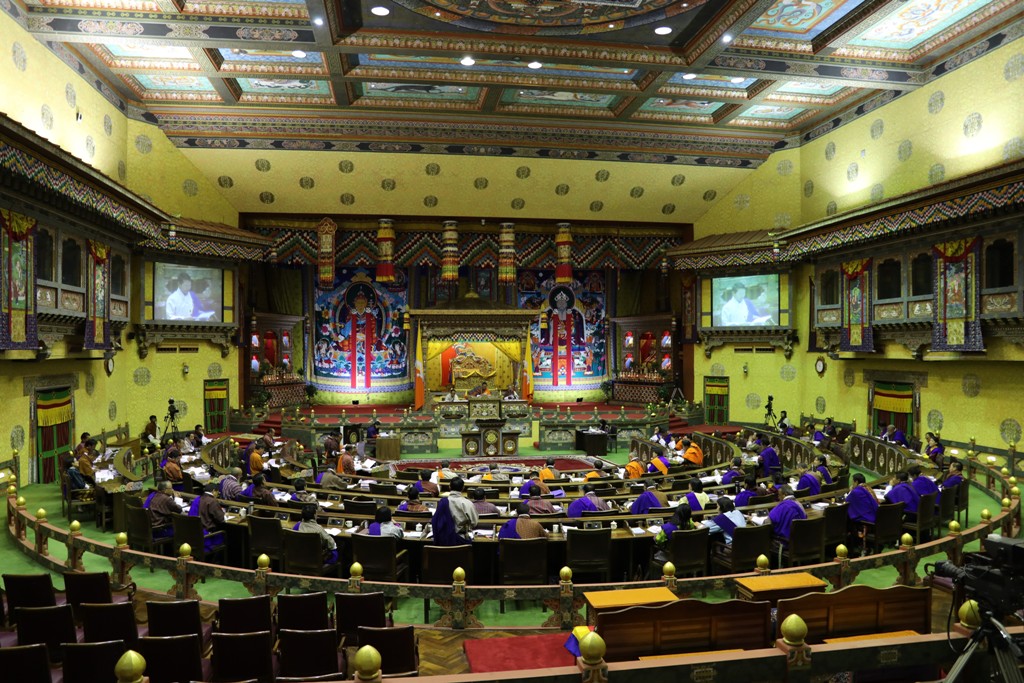
The Gewog Tshogde is in charge of recruiting and appointing Gaydrungs (Gewog clerks) according to the Local Government Rules and Regulations of 2012, and they are responsible for managing the affairs of their respective Gewogs.
Every Gewog should have an Administrative Officer (GAO), Accounts personnel, and Engineer, according to the Local Government (Amendment) Act 2014. The Gaydrungs, on the other hand, are not referenced in the Local Government Act nor recommended in the RCSC’s OD report. In fact, an Organizational Development (OD) exercise conducted by the Royal Civil Service Commission (RCSC) determined that the positions were not required.
There has been significant discussion about Gaydrung’s relevancy, as their roles might be handled by Gewog Administrative Officers and Accounts personnel. On the other hand, LG officials maintain that Gaydrung plays an indispensable role in public service delivery.
As a result of the aforementioned development, there is a discussion about the role of Gaydrung in the Gewog Administration’s functioning. Consequently, in 2019, the Ministry of Home and Cultural Affairs’ Department of Local Governance performed a study to offer evidence on the importance of Gaydrungs in the Gewog Administration’s functioning. The survey included representatives from 6 Dzongkhags, 12 Gewogs, 48 Chiwogs, and 480 households from across the country.
The study recommended that the post of Gaydrung be retained and regularized the Gaydrung post, which is the most viable and feasible solution at the moment. Further, the study recommended that Gaydrung’s post-qualification be fixed at Class 12 with proficiency in Dzongkha and good years of office management training.
However, the Royal Civil Service Commission (RCSC) and the Government decided to discontinue the post of Gaydrung after the recent local Government (LG) elections (April 6, 2022).
On the contrary, the Opposition Party accused the Government of breaching the National Assembly’s resolution, which was passed on January 16, 2019, and its subsequent commitment to Gaydrungs on their retention. Further, the Opposition urged the Government to honour the resolution of the Parliament and re-consideration.
However, the Royal Civil Service Commission shall promote and ensure an independent and apolitical civil service as per Article 26 (1) of the Constitution and shall function in accordance with the Civil Service Act as per Article 26 (10) of the Constitution. Moreover, The BCSR 2018 states that the authority for amendment and interpretation of any provision under the BCSR 2018 shall rest with the RCSC, and its interpretation shall be final and binding.
Therefore, the National Assembly’s resolution passed on January 16, 2019, to ‘Retain the post of Gaydrung under Gewog Administrations’ is inconsistent with the Constitution and shall be considered null and void as per Article 1 (10) of the Constitution. The Constitution is the source of law, and the governmental organs derive their powers from its provisions. They must function within the framework of the Constitution, and their actions must be consistent with the requirements of the Constitution. Moreover, the Parliament’s resolutions, except on legislative bills, international conventions and protocols, are not necessarily binding.
The following points are proposed for the Government’s kind consideration:
- The Government may consider amending the Local Government Act of Bhutan 2014 if the Department of Local Government’s (DLG) recommendation on the significance of Gaydrung in Gewog Administrations in 2019 is legitimate and urgent. However, a comprehensive review needs to be carried out by an independent institution to avoid a conflict of interest. Moreover, the previous study had limited sampling sizes of 6 Dzongkhags, 12 Gewogs and 48 Chiwogs only.
- If the Government is concerned about the capacity of local Government, it is strongly recommended that Section 265 of the Local Government (Amendment) Act 2014 be implemented, which mandates that every Gewog have an Administrative Officer (GAO), Accounts personnel, and an Engineer. This will strengthen the capacity of the LG functionaries and improve the efficiency of the public service delivery.
- Given the increased responsibility and budget at the local level, there is a need for a qualification requirement for local leaders. The present Government must demonstrate a strong political commitment to building the capability of our future LG leaders. The Gyaldrung job may become obsolete if all LG has a minimum qualification. Therefore, the Government may consider amending the Local Government Act of Bhutan 2014 to establish qualification requirements for LG leaders.
Last but not least, I applaud the Government’s recent decision to provide Gaydrungs with the special retirement scheme—a one-year basic salary starting from April this year and leave travel concession (LTC) and leave encashment in recognition of their dedicated service to the country as per the Pay Revision Act of 2019.
Disclaimer: The views and opinions expressed in this article are those of the author and do not necessarily reflect the official position of the affiliated organization.
Concerns on the fuel price hike
- March 17th, 2022
- 2,229 views

The fuel price has hiked more than doubled since May of last year, and the price of fuel is expected to continue until the global demand and supply stabilize. Prices are currently at a record high of Nu 95.19 a litre of petrol and Nu 100.55 a litre for diesel in Thimphu (As of 17-Mar-2022). Prices for a litre of petrol and diesel had spiked by more than 100% compared to May of last year when a litre of petrol was Nu 45.43 and a litre of diesel then cost Nu 37.88.
The considerable increase in fuel prices last year, according to economists, is attributable to the oil-producing countries’ reduced oil production. However, the current spike is partly due to the sanctions that the United States and other Western countries have imposed on Russia for its invasion of Ukraine. Severe sanctions on Russia aim to isolate the country and create a deep recession, but people worldwide will also feel the economic fallout.
Therefore, more attention needs to be paid to this issue because the fuel price increases have a cascading effect on overall commodity prices due to increasing transportation costs. Rising fuel prices affect those who own vehicles and those who do not. Consumers suffer more than suppliers of goods since rising fuel costs raises the cost of items supplied, and suppliers pass on most of the cost increases to consumers through higher prices. Suppliers are also impacted because they will not be able to sell as much at the higher price. Poor people in society, such as low-paid workers, daily wage field workers, and farmers who need to buy commodities, are the worst affected.
This is a topic of pivotal national importance; since we import oil and its global prices are impacted by a highly volatile market, our country is highly vulnerable to the balance of payment concerns since the pandemic has already impacted our economy. Further, when the cost of living increases, real income declines, and unemployment and poverty rates may rise if the Government does not act promptly.
Our GDP growth recorded an all-time low of -10.08 per cent in 2020, and the GDP for 2021 is expected to be around 3.5 per cent. Both Royal Monetary Authority (RMA) and the World Bank projects Bhutan’s GDP growth of more than 5 per cent in the financial year 2021-22 as the industrial and services sectors are expected to recover gradually.
With this backdrop, I would like to lay down a few recommendations for the Government’s urgent interventions:
- The Government needs to develop a plan of action, strategies, and policies to overcome the impact of rising fuel and overall prices at the micro and macro levels through price control mechanisms and providing subsidies to the oil distributors.
- The Government needs to reduce the vulnerabilities of the balance of payment due to global prices by revisiting the current economic contingency plans, improving market outcome, and preventing market failure caused by externalities.
- If the fuel price rises distort market dynamics and lead to hyperinflation (more than 50%), the Government needs to support poor people in society, such as low-paid workers, daily wage field workers, and farmers.
- It is high time that the Government needs to construct an Oil Reservoir where we can stock up when the Oil price falls below the average price and distribute when there are sudden hikes in prices like today.
Effective Civil Service Reform in Bhutan
- November 25th, 2021
- 6,732 views

His Majesty The King issued Royal Decree for Civil Service Reform during the 113th National Day celebrations in Punakha (Picture Courtesy: HM’s Facebook Page).
Since the establishment of the RCSC in 1981, several reform efforts have been made to improve civil servants’ competencies and performances. Nevertheless, the core impediments against developing a more professional and efficient bureaucracy remain entrenched in the system. Although the civil servant to population ratio is 1:25 as of 2019, inefficient service delivery has become an impediment to our national development and progress. This is evident from the Royal Kasho on Civil Service Reform issued to the RCSC during the 113th National Day Celebration. As His Majesty, the King desired, we must prepare for our future and adapt to the globalized world by capitalizing on being a small nation’s strength and opportunities.
Therefore, this study explores how our government could initiate civil service reform to achieve greater efficiency, effectiveness, and responsiveness towards public service delivery.
Why Civil Service Reform?
Recent studies have indicated that governments worldwide continuously aim to improve public service delivery, accountability and transparency to respond to citizens’ needs. Even governments with a high standard of public service delivery are under constant pressure to improve continuously (World Bank, 2020). Similarly, Kazakhstan’s government has developed a professional public workforce to improve its administrative efficiency and public service quality (OECD, 2018). Likewise, Xiaoqi (2012) highlighted that civil service reforms in China aim to promote administrative efficiency and help policymakers strengthen their control over the civil service to enable China to regulate and manage its increasingly complex economy and society. Moreover, civil service reform in ASEAN member countries concluded that reforming the public sector can narrow the government’s gap by creating an efficient and responsive public sector (Kim & Araya, 2012).
Some authors have also suggested that an efficient, transparent, responsive, and accountable public administration is paramount for a nation’s proper functioning and the primary means of achieving government strategies (UNDP, 2015). The literature review shows that governments have to reshape public sector leadership to deal with new challenges (OECD, 2001). Furthermore, the research concludes an analysis of 14 countries’ experiences to reduce public expenditures, improve policy responsiveness and implementation, improve government as an employer, improve service delivery, and build public and private sector confidence (Manning & Parison, 2003).
Obongo & Wilkins (2014) argued that governments worldwide have reacted to unprecedented economic challenges and rapid political and public expectations changes over the past two decades. This is evident from the OECD’s publication that Citizens’ rising demands and expectations concerning public services’ quality, increase pressure on the public administration to improve its efficiency and responsiveness and be innovative flexible in responding to longer-term issues (OECD, 2010).
Best Practices & Lessons Learnt
Singapore is leading all the ASEAN member countries regarding government effectiveness, control of corruption, and the rule of law. This is because its reform programs mainly target solving specific problems, a high standard of accountability to the government, and political leadership (Kim & Araya, 2012). Moreover, Singapore’s civil servants are one of the highest-paid to attract the most highly qualified candidates, encourage their retention, and deter any tendency towards personal corruption (IPPR, 2013). China’s experience also follows this in managing and reforming its civil service model for other Asian countries because of the institutionalization of civil service recruitment and competition and merit-based promotions, the instalment of transparency and predictability into the public personnel management system, and government promotion officials’ accountability as well as public participation (Xiaoqi, 2012). The experiences of Japan and Kazakhstan offer similar insights (Aoki, 2015; OECD, 2018).
There exists a very extensive literature on this issue and the majority of prior research indicated that the civil service’s effective performance depends on merit as the basis of recruitment, selection, pay-scale, performance appraisal and promotion and retention practices. Civil servants need practical training and career development, which would result in better organizational and individual performance. Consequently, successful reforms in these areas can substantially increase public service effectiveness and efficiency (OECD, 2001; Iqbal & Ahmad, 2006; World Bank, 2008; UNDP, 2015b). Therefore, reform initiatives could be prioritized within three main areas: delivery excellence, service-oriented civil servants, and effective and efficient, organizations critical to improving overall public services (World Bank, 2020). In contrast, Repucci (2014) argued that the civil service reform generally includes reforms in remuneration, human resources, downsizing and operational efficiencies.
The research indicated that an essential part of effective and accountable public-sector management is transforming available resources into maximum impact following political priorities (MoFA, Denmark, 2007; Manning & Parison, 2003). There is a need to change the government’s role from the regulator to the facilitator to progress the delivery of services to the people (Iqbal & Ahmad, 2006).
Reform Challenges & Way-forward
Although most countries introduced civil service reform programs to improve public service delivery, they have faced challenges such as the need for resources and adequate human capital, lack of willingness to change and weak monitoring processes, and strengthening the communication and understanding of the reform objective and more participation of citizens and civil society (Kim & Araya, 2012).
Thus, the future civil service reform needs to consider developing competency management, investments in its senior civil service system and developing a performance culture to ensure these systems have a real impact in professionalizing the civil service and developing greater efficiency and performance (OECD, 2018).
When designing CSR programs, the main issues commonly faced are training, career Vs. position system, civil service management arrangements, pay and compensation, gender equity and performance management, politicization and patronage (UNDP, 2015). In a series of analyses and reports, the World Bank recognized the enormous challenge of civil-service reform operations, and it has recognized that success has been limited (Shepherd, 2003).
In this regard, Repucci (2014) suggested a broad framework when designing and implementing reforms. The challenges related to the context in which civil service reforms occur and how practitioners can overcome them are the importance of local context, political will and local ownership, weak institutions, systems of patronage, the long‐term nature of reform and sustainable reform. The challenges related to practitioners’ processes and procedures when implementing reforms are prioritizing reform, participatory processes, donor coordination, and the debate between comprehensive and incremental reform (Repucci, 2014; Obongo & Wilkins, 2014).
Therefore, Polidano (2001) emphasized that the strategic and tactical choices can determine the success of the design and implementation of civil service reform. Keeping the scope of change narrow, limiting aid donors’ role, and reform leadership are crucial factors for successful civil service reform. In summary, successful reform requires focus, the mobilization of resources, incentives, persistence and a strategy that puts reform on the political agenda (OECD, 2005).
Analysis: Local Context
The analysis was carried out based on worldwide governance (service delivery) indicators using the Percentile rank method (Daniel et al., 2010).
Effectiveness of Government captures perceptions of the quality of the civil service or public services. The study finds that the government’s effectiveness has a significant positive impact on a country’s growth performance and is associated with higher GDP growth rates over time (Han et al., 2014).
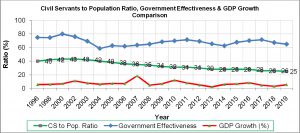
Figure 1: Government Effectiveness (Source: NSB and RCSC).
The strength of the civil service in Bhutan as of 2019 end was 29,442 (Annual Report, 2019). The civil servant to population ratio is 1:25 as of 2019 compared to 1:40 in 1996. Although the civil service size has almost doubled over the last two decades, the government effectiveness has declined to 64.90% (2019) from 74.86% (1996), with an average of 68.36%. Furthermore, the average GDP growth rate is 7.06%, with the highest growth rate observed in 2007 at 18.36%, mainly due to the commissioning of the Tala Hydropower Project (Figure 1).
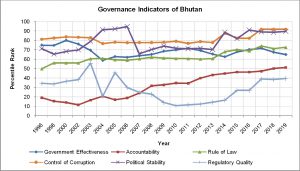
Figure 2: Governance Indicators (Source: Worldwide Governance Database).
The effectiveness of the government has improved in recent years with an average of 68.36% (Figure 2) compared to most countries in the South Asia region. The government’s effectiveness is determined by the organizational environment (economic development & education status), organizational characteristics (size and diversity) and political characteristics. Therefore, the government effectiveness measures the perceptions of the quality of the civil service, the quality of public services, the quality of policy formulation and implementation, and the credibility of the government’s commitment to such policies and the degree of its independence from political pressures (Sánchez et al., 2013). Moreover, low productivity of the civil service due to low competency, lack of a proper performance management system, and low motivation affect the government’s effectiveness.
The World Bank’s report on the ease of doing business, 2019, which compares business regulation for domestic firms in 190 economies, placed Bhutan in the 81st position, down from 75th in 2018. Due to too much reliance on the bureaucratic procedures involved in both the civil service and public organizations. For instance, it takes 61 days to get an electricity connection in Bhutan, whereas it takes only 26 days in Singapore. Similarly, it takes 12 days and 8 procedures to start a business in Bhutan, whereas it takes less than 2 days to start a business in Singapore. Such lengthy processes may discourage FDI due to unnecessary procedures required in business setup and operations.
The Constitution guarantees citizens to select the government and provides avenues to air their opinions (including through free media) on how services are being delivered to them and hold to account those that provide such services. This is only possible when there is transparency in how the government operates. In recent years, accountability in Bhutan has been improving drastically, with a rank of more than 51% (Figure 2) compared to most countries in South Asia region except India.
The system of displaced complacency where the system is protecting bureaucrats more than bureaucrats protecting the system has resulted in the civil servants’ failure to adapt to the dynamic nature of development and service requirements over time (Kuensel, 2021). Although Article 26 (1) of the Constitution guarantees the RCSC discharge its public duties in an efficient, transparent and accountable manner, both the CSA 2010 and BCSR 2018 emphasize only the ethics and integrity of civil servants without providing ample legal procedures to fix the accountability (Tshering, 2020). The lack of clear direction on improving accountability has resulted in civil servants violating their ethics and integrity and officials abusing power in service delivery.
Both regionally and globally, the corruption level is perceived to be low in Bhutan, with an average of 81.84% (Figure 2). Recently published National Integrity Assessment 2019 indicates that the experience of corruption in service delivery is minimal, but the perception of corruption in favouritism is prevalent in public service delivery (ACC, 2020). The lack of transparency and e-services; people availing services from the agency are making payments in cash, kind, services or other forms of gratification to public officials.
Since 1907, Bhutan has enjoyed a stable political environment engendered by our successive Kings’ dedicated and selfless leadership. With the constant nurturing of democracy, political reforms have been introduced during the last 100 years of Monarchy, the latest being the adoption of the Constitution in 2008. Bhutan’s political stability is best among Asia’s countries, with an average of 78.79% (Figure 2).
However, the change of government every five years since 2008 also hindered development activities and impacted bureaucratic efficiency due to lack of continued political will and significant changes in policy as per the political ideology.
The RGoB’s ability to formulate and implement sound policies and regulations for promoting private sector development is fragile amongst Asia, with an average of 28.16% (Figure 2). The major challenge of private sector development is the lack of access to markets for our goods and services. Our economic dependence on a few sectors and the composition of firms and investments in developing new and existing markets have been less than optimal.
Recommendations:
Based on the study findings, to achieve greater efficiency and effectiveness, and responsiveness towards public service delivery, the following recommendations are proposed.
- Enhance the effectiveness of government through rightsizing the civil service, meritocratic approach to civil service employment, applicable performance management system, contemporary and effective HR policies, fair remuneration for civil servants, practical training and career development and strengthening ethical leadership.
- Improve public service delivery through transparency, professionalism and accountability.
- Strengthen mechanism to address accountability issues and provide clear direction for fixing accountability through stringent legislation and rules.
- Reduce corruption by fostering integrity in the system. Strengthening e-services for service delivery can help optimize HR and budget and assure transparency in public service delivery.
- Promote private sector development with an accessible market both within and abroad to reduce the burden on the civil service and the demand for civil service jobs through the formulation and implementation of sound policies and regulations. Moreover, change the role of the government of the regulator to the facilitator for effective public service delivery.
- Ensure strong political will and local ownership of successful civil service reform to put reform on the political agenda, engage the local government in the process, and help develop the approach for effective implementation of the civil service reform.
NB: The author declares that the material being presented in this paper is the author’s original work unless cited. The author reserves the rights of the content, and in the case of republication of the whole, part, or parts thereof needs to be acknowledged.
Why didn’t I support the Tobacco Control (Amendment) Bill of Bhutan 2021?
- July 5th, 2021
- 3,647 views
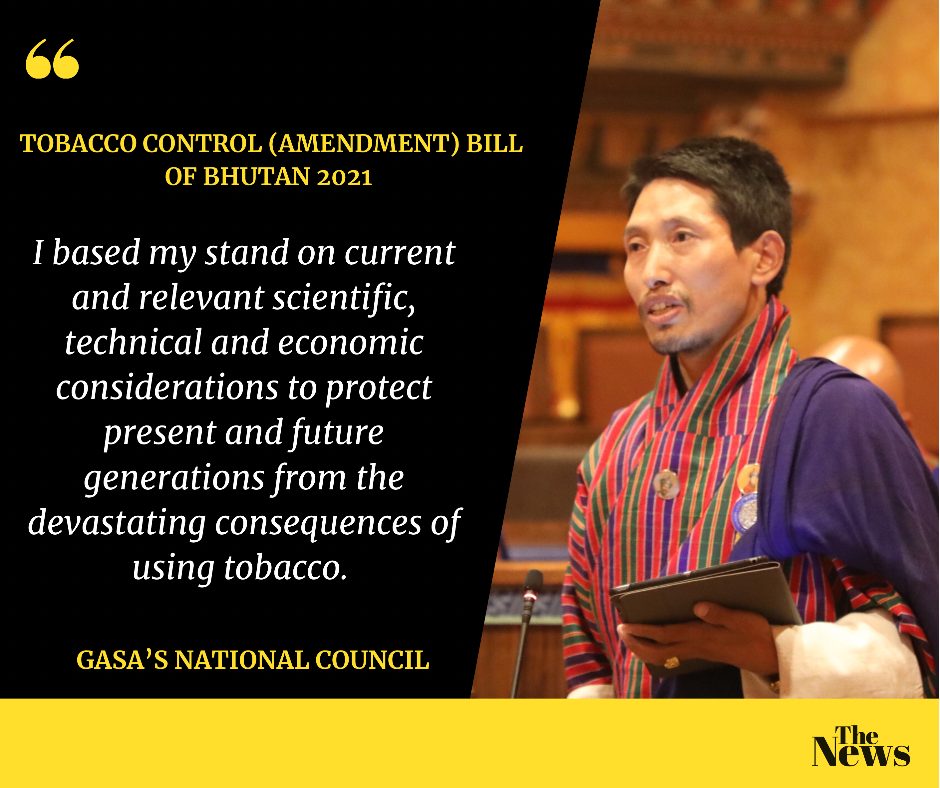
The parliamentarians in the past invested so much time and resources in deliberating the Tobacco Control Acts, but the recent amendment easily sailed through both the Houses of the Parliament without much debate, on the pre-condition that it is an “Urgent Bill.”
However, I could not support the amendment bill.
It was not because I am a superstitious or hypocrite. I based my stand on current and relevant scientific, technical and economic considerations to protect present and future generations from the devastating consequences of using tobacco. I always stand by my principle – the interest of the nation and the people. Furthermore, the Kantianism Theory rightly stated that an action is morally right if it is motivated by the goodwill that stems from a sense of duty.
Legal Framework
Since Bhutan ratified the World Health Organization’s Framework Convention on Tobacco Control (WHO FCTC) on 23rd August 2004, the country prohibited cultivation, harvesting, manufacture, supply, distribution and sale of tobacco products through the enactment of the Tobacco Control Act of Bhutan 2010 (amendment 2012 and 2014) and enactment of the Rules and Regulations 2011 (amendment 2013 and 2015).
The Parliament enacted the Tobacco Control Act in 2010 and deliberated on amendments in six parliament sessions, considering the following points.
- Concerning the physical health and well being of the people of Bhutan, which are important elements of the development principle of Gross National Happiness.
- Recognizing the harmful effects of tobacco consumption and exposure to tobacco smoke from a spiritual and social health perspective.
- Recalling that the National Assembly of Bhutan, during the 82nd session held on 12th August 2004, ratified the WHO Framework Convention on Tobacco Control (FCTC).
- Acknowledging that as a party to the WHO Framework Convention on Tobacco Control, Bhutan is implied by its provisions to implement it through national legislation and policies to fulfil the obligations, and
- To Ensure the effective control of tobacco and tobacco-related products
The banning isn’t a solution nor making tobacco readily available and affordable is a wise decision. The existing legislation ensures non-smoking areas, offences and fines for buying tobacco products, restrictions on advertisement and promotion, and procedures of import for personal consumption.
Health Implications
Tobacco continues to be the leading cause of preventable non-communicable disease, deaths and disability – affecting people in the most productive years. According to a World Health Organization report, the tobacco epidemic is one of the biggest public health threats: more than 8 million people die in a year worldwide. More than 7 million deaths were from direct tobacco use, while around 1.2 million deaths related to second-hand smoke.
WHO Office for Southeast Asia reported that tobacco kills an estimated 221 people each year in Bhutan. Among others, heart disease and stroke are the most common ways people die of tobacco use. Most people start early, increasing the risk of heart disease in younger people – the mean age of initiation stands at 18.9 years.
Therefore, Tobacco control is essential for preventing and controlling deaths and disabilities. More than 120,000 active tobacco users and those exposed to secondhand smoke are at increased risk of cardiovascular diseases.
Tobacco-related mortalities would rise while the average life expectancy of 71.46 would be reduced.
Evidence suggests that the severity of COVID-19 is higher among smokers. The COVID-19 fatalities are higher among people with pre-existing conditions, including non-communicable diseases such as cardiovascular and chronic respiratory conditions, cancer, and diabetes.
Therefore, the recent amendment of the TCA (2021) could also defeat the Ministry of Health’s strategy to gain herd immunity to combat the pandemic.
Economical Implications
Over 80% of tobacco users are in low and middle-income countries, where the burden of tobacco-related illness and death are the heaviest. Tobacco use leads to poverty by diverting household spending from basic needs to tobacco.
Findings from the 5th Global Youth Tobacco Survey revealed that more than one out of five students (22.2%) currently use tobacco products (2019). The prevalence of current cigarette smoking was 14.7%. 12.5% of students currently consume smokeless tobacco products.
Despite the stringent laws, tobacco consumption remained high in Bhutan, and youth start using it at a very young age. The recent amendment of the Tobacco Control Act has exposed an economically productive population (30–69 years) of 3,32 000 (41%) and a youth population (13–17 years) of 73 000 (9%) to the risk associated with tobacco use.
Therefore, the economic costs of tobacco use are substantial and include high health care costs.
Social and culture Implications
The recent amendment of the TCA (2021) will have an impact on individuals, families, and the nation. Research indicates that the poor are the ones who smoke the most. Tobacco worsens poverty among its users. Smoking accounts for much of the mortality gap between rich and poor.
Tobacco use imposes a heavy burden on society and families by – increasing illnesses and deaths – affect the economic situation of tobacco users and their dependents. There is also a threat to the environment.
Tobacco-related diseases kill one-fourth of smokers in the middle of their active life, which will seriously impact family members dependent on their income.
Treatment of tobacco-related illnesses is costly: heavy burden on governments’ finance; high-income countries account for 6-15% of annual healthcare cost.
Loss of productivity due to ill health: smokers have about 50% more sick days than non-smokers, more early retirement, lost working years from premature death.
Smoking has many adverse reproductive and early childhood effects, including an increased risk for infertility, preterm delivery, stillbirth, low birth weight and sudden infant death syndrome (SIDS). Women smokers often have symptoms of menopause about three years earlier than non-smokers.
The government’s recent decision on tobacco, making it freely available in the market is also against the Buddhist doctrine and religiously sensitive to discuss. Let the law of Karma take care of itself.
Will the TCA (Amendment) stop smuggling in the border areas?
The government presented the Tobacco Control (Amendment) Bill saying that tobacco smuggling cases had increased with the imposition of restrictions at the points of entry at the southern borders, and the smuggling caused security risks in the country.
The Southern Covid-19 Task Force had pointed out that tobacco smuggling was the main reason for the spread of Covid-19 in the southern dzongkhags, as presented by the Economic affairs minister. The government believes that tobacco will be readily available at lower prices if the Act is amended, and the smuggling cases will fall. On contrary, the minister also confessed that the Duty-Free Limited had not adequately served all consumers, although Bhutan Duty-Free Limited is one of the State-Owned Enterprises under the Ministry of Finance.
If what the government claim is valid, how about the drugs-related smugglings in the border areas?
A short comparative analysis between the tobacco and drugs smugglings shows equal security risks:
- In 2018 the Royal Bhutan Police (RBP) under Chhukha Dzongkhag registered 158 drug-related cases (TheBhutanese, 01/26/2019).
- Royal Bhutan Police (RBP) registered 192 drugs and tobacco-related cases and arrested 985 people in connection to 192 cases. Moreover, Thimphu police have registered 140 cases and arrested 336 people in connection to drug cases (TheBhutanese, 07/26/2020).
- Regarding tobacco, as per the Office of Attorney General, the number of tobacco-related cases had increased from 16 in 2019 to 42 in 2020 and 14 in the first six months of 2021. Moreover, about 307 cases of tobacco smuggling were recorded between 2020 and 2021.
Considering these facts, unless the government addresses the security risk posed due to drugs smuggling in the border area, the mere amendment of the tobacco control does not serve the intended purpose. However, I am neither recommending the government to legalize the drugs nor support the tobacco control (amendment) bill 2021.
Nevertheless, the amendment’s implications for the future of the nation and people are beyond impairment.
The government had also waived 100 percent tax with the amendment of the Tax Bill of Bhutan 2021, which makes the situation even worse. Tobacco will be readily available and affordable, turning it into everyone’s choice.
WE ARE SETTING HOME ON FIRE JUST TO KILL RATS!
Question to Minister of MoAF on Cordyceps Collection Issues
- May 29th, 2021
- 2,061 views
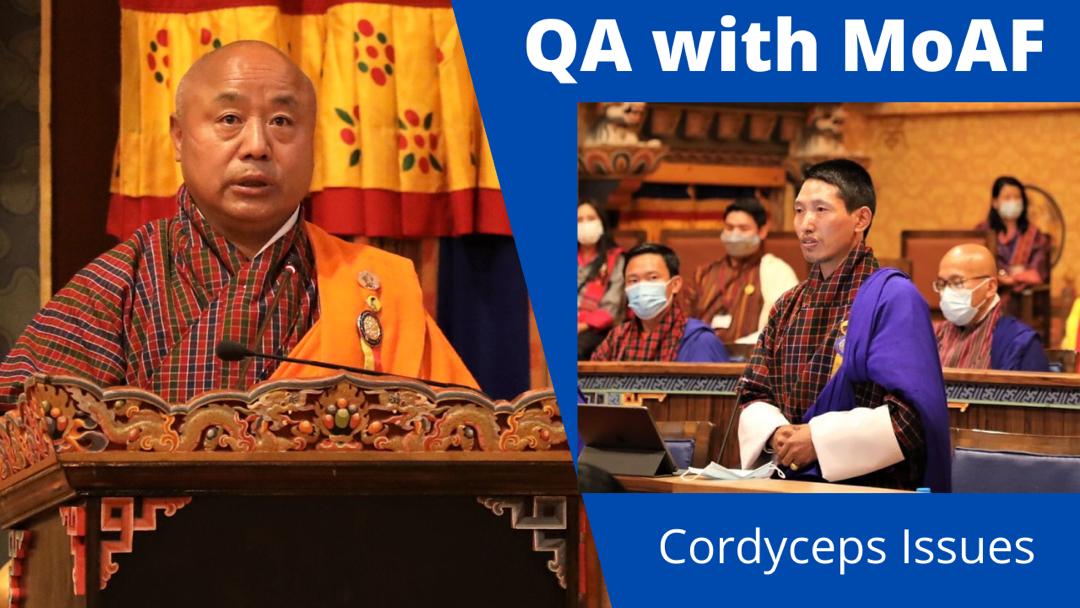
The legalization of cordyceps collection following the Royal Command issued by His Majesty the King in June 2004 has tremendously improved the living conditions of the people in highland dzongkhags (Kuensel, 2005). The slaughtering of yak for meat dropped, and equality improved among the highlanders, dispelling division between haves and have-nots in the community. The policy prevented poachers from across the border and encouraged highlanders to stay in their community, safeguarding our border areas in the north.
The Ministry of Agriculture and Forests (MoAF) presented to the National Council on the legalization of Paris Polyphylla and cordyceps harvesting period, amongst other issues (Royal Banquet Hall on 12th September 2018). During the consultation meeting, members asked about the possibility of providing adequate preparatory days to collect cordyceps. The officials of MoAF informed the committee that they would inform the House with proper research and accurate information. However, the committee did not receive any update so far.
Our consultations with Local Government Leaders of 14 gewogs in 7 dzongkhags found out those preparatory days differed from gewogs to gewogs. Some gewogs were provided only 2 days besides a one-month collection period.
On 30th May 2020, Dangchhu, Gangtey, Kazhi and Saephu gewogs had also requested an extension of collection days for two weeks.
The House acknowledges MoAF for extending two weeks to the highland communities in 2020 as the year was affected by late snowfall; unprecedented heavy rainfall was impacted by cyclone ‘AMPHAN’ and other extreme weather patterns (Ref.: MOAF/DDFPS/2020/333, dated on 2nd June 2020). The time extension was expected to help a highland society economically because cordyceps are the primary sources of livelihood.
Due to varying climatic condition, collectors need at least 2 weeks of preparation besides a one-month collection period. This will also address the conflict between the cordyceps collectors and forest officials in the field.
During the National Council’s review workshop at Institute for Management Studies Limited (IMSL) on 12th and 13th April 2021, these issues were highlighted to be genuine. The House directed the committee for the concerned Minister to update the status on the extension of preparatory days for cordyceps collection.
The cost of cordyceps started with less than Nu. 60,000 per kilogram in 2004 and now fetched an average of Nu. 1 million per kg (Cordycep Report, 2019). The records show that an average of 400 kg of Cordyceps Sinensis auctioned every year worth more than Nu 200 million. It is one of the export products and contributed more than 3 million royalties every year besides business income tax to the government and other economic and social benefits.
Considering all the above points, the National Council hereby asks the MoAF Minister to clarify the following to the general public:
- Section 5.1 of the Guidelines for the collection of Ophiocordyceps Sinensis for 2014 has not been implemented effectively. The distance from the remotest villages and Chiwogs to the collection site is not considered. Is there a possibility of providing an adequate preparatory period for the cordyceps collectors considering the economic and social benefit to the country?
- Has the government incorporated the possibility of extending the collection period considering the severity of climatic factors in the revised guidelines?
- What management plans is the government developing to promote sustainable harvesting of cordyceps?
- Cordyceps collectors of Lunana and Wangdue involved in boundary dispute (Kuensel, 2018). How is the government planning to address the border demarcation issues between the gewogs and the inter dzongkhags?
Minister’s Response
- Preparatory period
The Minister informed the House that the collection time and permit for cordyceps collection were not uniform across the growing areas because of the different growing times of the Ophiocordyceps Sinensis. The local government has the full authority to decide on the preparatory period, as they know the ground reality for the collection period, situation, and the background of the collectors. The Minister also said that the Ministry would approve the extension if they receive the resolution and proposal from Dzongkhag Tshogdue.
Comment: The Minister’s statement is loud and clear that the LG leaders have full authority to provide an adequate preparatory period for the collectors, and other officials also should take note of it.
- During the severity of climatic factors
Earlier, the collection time was only for one month, including the travel time, but since 2013, the collection was allowed for one month, excluding the number of days of journey, to and from the collection site. In 2020, based on local weather conditions and considering the pandemic situation, the RGOB extended collection time by two weeks in addition to the previously allotted collection time of one month. The Minister emphasized that the Ministry would continue to support depending upon the climatic conditions in consultation with the LG leaders in the future.
Comment: We are delighted with the government’s response on the extension of the collection period during the severity of climate factors. However, we insist that it should be incorporated in the revised guidelines. It should be systematic but not at the whims of politics.
- For sustainable harvesting of Cordyceps
Sustainable harvesting of Cordyceps:
- Limiting collection of cordyceps to 3 people per household
- Restricting the collection period to one month to allow mature spores to germinate
Comment: We felt that the government should develop more holistic, sustainable harvesting programs such as proper waster management, improve R&D on Cordyceps domestication and installing weather reading instruments in the collection sites for climate impact studies.
- On Boundary Issues
MoAF has no authority over the border demarcation issues. However, the Minister said that a consultation meeting with the National Land Commission is underway. Once finalized, the Minister would inform both the House accordingly.
- As per the guidelines for collection/harvesting of Ophiocordyceps Sinesis of 2019, the Department of Forest & Park Services (DoFPS) is mandated to monitor the collection of cordyceps and issuance of collection permit books to the Gewog through the respective Parks and Division offices once the areas have been identified.
- In addition, section 10 of the guidelines state, “The collection of Ophiocordyceps Sinensis shall be allowed only within the respective Gewog boundary or administrative jurisdiction having traditional rights”.
- Similarly, section 43 states that “In the event of any conflicts arising out of ambiguous boundaries between the Gewogs, the concerned Dzongkhag shall resolve such conflicts through Dzongkhag Tshogdu”.
- Recently a letter was sent to the National Land Commission dated 4th May 2021, letter no. 413 to clarify the cordyceps collection boundary between Wangdue & Bumthang Dzongkhag.
Comment: It was observed that a letter which was sent to the National Land Commission was for boundary conflict between Wangdue & Bumthang Dzongkhag. It seems that MoAF has not taken any initiative concerning the border conflict between Gasa & Wangdue Dzongkhag. Therefore, we would further recommend that the MoAF and the concerned authorities take prompt action in resolving the border issues.
Follow-up Report on the Resolutions of the 26th Session of the National Council
- May 28th, 2021
- 1,707 views
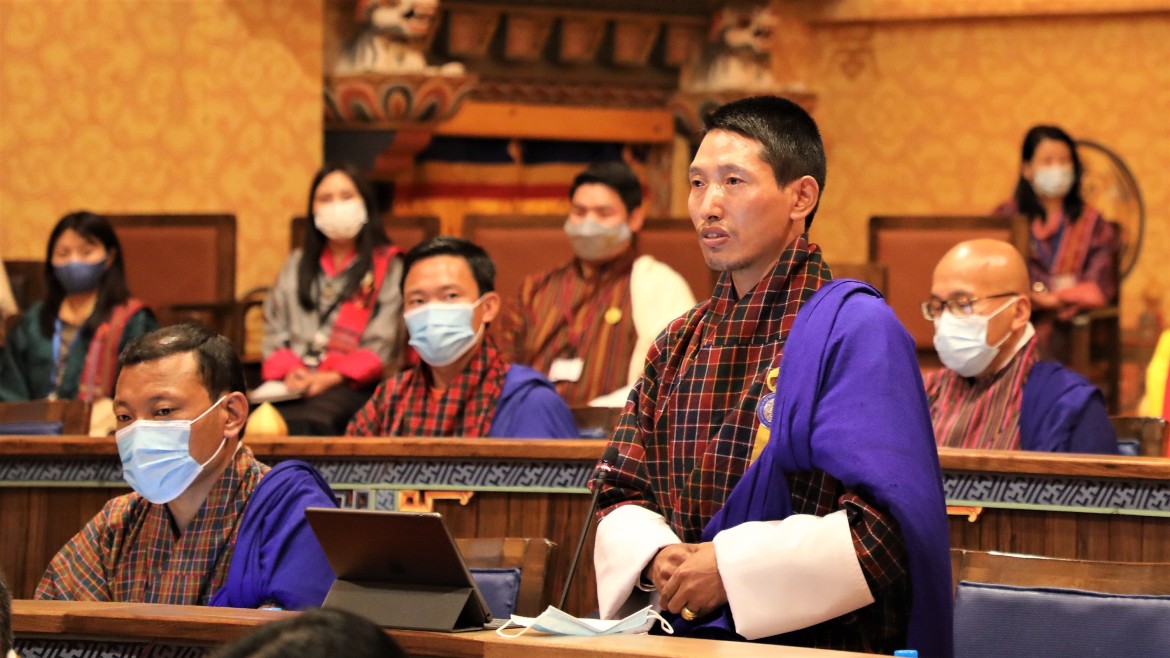
Recommendation I
The analysis of 10 years of data from 2010 to 2019 exposed the following cross-cutting issues related to production and marketing:
- There exists a huge gap between the import and production of vegetables for tomatoes and onions,
- The productivity of cash crops such as apples and oranges are stagnant but increase in their import
- The import of never exported fruits such as banana, mangoes, papayas, pineapples and watermelon have been increasing
- The products such as apples shelled betel nuts and ginger are imported at a higher price than export.
Some of these crosscutting issues are expected to be addressed through the implementation of 3 years marketing action plan, which was approved in the 1st Multi-Sectoral Committee (MSC) meeting and Agriculture Economic Contingency Plan 2020. But, MSC has become weak by reducing the quarterly meeting required in the Policy to twice in the Terms of Reference and became non-functional for having met only once since the inception of the policy. The difficulty of getting common conveyance for the Committee meeting and having indecisive representatives from other stakeholders could have been discussed and resolved if the subsequent MSC meeting was held. Moreover, any crosscutting issue would have been the discussion points in the meeting and consequently strategized the appropriate action plans. Therefore, MSC has to be functional in order to put the marketing system in place by coordinating and harmonizing the approaches of all involved stakeholders as per the Policy and Terms of Reference.
Response:
A Multi-Sectoral Committee (MSC), following the RNR Marketing Policy 2018, was formed to address the Marketing issues of the cross-sectoral agencies.
After the formation of this committee, we organized the first meeting where the ToR of the MSC was finalized. We attempted for further meetings seeking agenda from the sectoral agencies. Having received no pertinent issues as an agenda, the secretariat of MSC couldn’t organize follow up meetings.
However, as this MSC meeting is important and as recommended by NC, the ministry will activate the committee and the meeting. The next meeting is scheduled for May 2021.
Recommendation II:
Various market infrastructures such as cold store, naturally ventilated store, large market, roadside market, farm shop, cooperative shop, sales outlet, packhouse, warehouse, processing equipment and others have been established by the Ministry and most are functional. Most of the infrastructures have been established independently by the Department of Agriculture Marketing & Cooperatives (DAMC) and the National Post Harvest Centre (NPHC). From the field visits, it was found that most farm shops have limited storage space, roadside collection sheds have no toilet facility and only a few cold stores and other farm-level stores, which could assure longer storage life of products, have been established.
Having learned a lesson from COVID-19 and to deliver faster and better services, MoAF in collaboration with Thromde is establishing vegetable market sheds at other appropriate locations without having a future utilization plan of the existing Centenary Farmers’ Market.
During the Nationwide Lockdown because of COVID-19, people had access only to a limited quantity and variety of vegetables as the import of vegetables has been temporarily restricted. Also, many locally grown products like cabbages and ginger were spoiled when the export could not be done. It confirms the limited storage and processing facilities and poor distribution channels for fresh vegetables.
Thus, there is a need to establish smaller capacity cold stores at strategic locations facilitated by refrigerated vans, other low-cost farm level stores, future utilization plan of Centenary Farmers’ Market and small-scale processing equipment to improve the distribution of fresh and processed quality products within the country and export.
Response:
The development of market infrastructure for public use is one of the important strategies to facilitate marketing. In the fiscal year 2019-2020, the Department has supported the constructions of 17 market infrastructures including a large market facility in Dagana and Mongar.
In line with the need to build storage capacity in the country, the Ministry in collaboration with FCBL has initiated the establishment of 3 integrated Cold Stores and Warehouses-one each in Sarpang, Tashigang and Wangdue. These facilities are due for completion by August 2021. Further, the establishments of 5 Cold Stores are proposed in the forthcoming fiscal year 2021-2022. SOEs such as FCBL and BLDCL were supported with the Refrigerated Vans.
The establishment of small capacity cold stores by private parties is also encouraged and ensured with support through cost-sharing mechanisms of 80:20 ratio i.e. the share of investment of 80% by the proponent and 20% by the Government. The Ministry has also issued a letter of interests to the private entrepreneurs for leasing of land and availing financial loans for the establishment of such structures.
The Ministry, as in the past, is continuously supporting producer farmers and processors with small scale processing equipment mainly through farmers group and cooperative development programs. For the coming financial year, the department has invited expression of interest for financial support to set up the cottage and small scale RNR based enterprises
Recommendation III:
Various market studies are carried out and uploaded on the DAMC’s website. Some of the findings of the studies are captured in the action plans of the Department but there is no assured coordination among the stakeholders for the implementation of the findings of the studies, for example, initiating the production of suitable cardamom variety for an international market.
Though the RNR-Enterprise Coordination Unit is going to facilitate with regards to enterprise development, any intervention is somehow delayed because the DAMC has to collaborate with multi-stakeholders especially the NPHC, implementing the value addition as well as market infrastructure, has no direct interaction in planning since NPHC is under the management of different Department, Department of Agriculture.
Under the financial scheme such as Corporate Business Development Scheme, buyback scheme and school and hospital program have benefited the farmers though implemented based on the budget availability.
With the introduction of the Good and Service Taxation system in India, the export of fresh produce faces some problems where the products get stranded unless there is prompt intervention from the concerned authority. With these hiccups, the products get spoiled and result in economic loss to the people.
There is a need to establish mechanisms among the stakeholders for
- Discussing the findings of market studies, for example, initiating the production of suitable cardamom variety for the international market
- Adoption of technically feasible processed products through stronger and formal collaboration between DAMC and NPHC
There has to be a continuous support to the existing financial schemes with sufficient budget and good public awareness.
The current stranded problem of fresh produce export has to be resolved in advance by working in collaboration with the counterpart authority.
Response:
In reference to resolving of issue of the stranded problem of fresh produce export various actions have been taken:
- The Ministry in collaboration with the Foreign Ministry has taken up the export trade regulatory issues with GOI and resolved them.
- The Ministry deputed marketing officials at Phuentsholing and facilitated the fresh produce export through the establishment of a dedicated agricultural export transhipment facility, escorting of outbound vehicles from green zones to transhipment facility and implementing the COVID 19 containment measures during the export.
- Producers/Exporters were linked with the potential buyers across the borders.
- Activated buyback scheme for those commodities such as cabbage and ginger which has a very low export price.
- Distribution and linking with domestic markets were facilitated
Recommendation IV:
Agriculture Marketing Information System (AMIS) is accessible through an online system as well as mobile apps. The online system has real-time prices of 37 commodities located in 23 markets across the country. It will also have information on the latest auction market prices linked through the Food Corporation of Bhutan. However, there is no information on the quantity of products required by the market and the public are not aware of AMIS.
To have better information, it is good to incorporate the estimated quantity of products required per market in the AMIS and also display it on TV screens in the Market. If possible, the estimated quantity, location of the products and cost of production needed to be incorporated in AMIS. Further public awareness of AMIS has to be carried out.
Response:
The Agricultural Market Information System (AMIS) was launched towards the end of June 2020 covering price market information of 37 commodities from 23 markets across the country. In addition, the provision of information on the latest auction market process is also linked with the Food Corporation of Bhutan Limited. Recently, two additional markets under Thimphu Thromde and two additional commodities have been also added into the system- thereby taking the total number of markets covers to 25 and commodities to 39. Over time, we wish to increase the coverage both of the market and commodity-based on the requirement. However, as submitted earlier, one of the current limitations of the AMIS is the volume traded per market. Towards this end, the department through the project (EU-ITC), which supported the development of AMIS explored various options and means to capture the volume traded in each market. However, given the complexity in capturing such data from each market and having into the system, the department was advised that from the experiences of such systems in other countries, the best option would be to go for one time survey to capture the volume aspect, which will definitely add up to the cost. At the moment, the department is exploring how best to incorporate the volume aspect with the support of EU-ITC into the current AMIS.
MINISTRY OF FINANCE (MoF)
Recommendation V:
The availability of CSI banking service at Gewog Level has reduced the travel of people to the Dzongkhag and the online application has reduced the administrative burden but the delay of loan approval is a concern for the loan applicants. The disqualification of loan application criteria as per the credit manual 2020 is not available on the CSI website for the public. The technical recommendation letter from the respective department has to be produced manually. Therefore, CSI bank has to upload the disqualification of loan application criteria on the website and need to work for providing the technical recommendation letters from the respective Department electronically. Further, the management has to expedite the loan approval by setting the turnaround time for every loan portfolio.
Response:
- The delay in the loan approval happened last year mainly because of the following reasons:
- Increase in unexpected numbers of applicants (especially in response to monetary measures of RMA wherein interest rates were reduced).
- National lockdown on two occasions from August 11th to 11th September and December 2020 to January 2021, severely hampered the bank to manage the loans.
- As the new Core Banking Solution (CBS) system was underway, all the applications were processed manually. However, CBS is on trial starting this month.
By the end of 2020, the bank had almost 2000 pending applications. The pending applications were completed only recently. Now, the bank expediting the process and reduce the turnaround time for Microloan ( Loans up to Nu. 500,000) to a maximum of 10 working days and for CSI loan to less than 21 days. To make it possible, the bank has started to approve the loans on a weekly basis and sign the legal documents at the geog level through CSE without requiring the applicants to report to the HQ/Dzongkhag office as it used to be in the past.
- CSI bank credit manual contains eligible criteria and conditions for loan application but does not specify the disqualification criteria for loan applicants and the manual is for internal use and can’t be given on the website. Although the rejection loan applicants very low, these are based on the nature of projects and their feasibility, completeness of required documents and consonance with the bank’s mandate. However, the bank has uploaded eligibility criteria on the bank’s website along with the checklist.
- We already have the practice of receiving technical clearances from agriculture and livestock officers from the Gewogs. This information is electronically transmitted to the approving authority of the bank.
During the deliberation, some members expressed dissatisfaction with the responses received, particularly on three recommendations (1, 3 and 5). Hence the House directed the Natural Resources and Environment Committee (NREC) to re-deliberate with the concerned members and issues to be resolved accordingly.
Gasa Dzongkhag’s Mid-Term Review Report
- May 15th, 2021
- 1,926 views

Gasa dzongkhag’s Mid-Term Review (MTR) for the 12th FYP was held on 14th May 2021. The Government looked into the status of development activities at the Local Government, quality of service delivery, budget allocation, explored ways to improve performance, understand challenges, and the way forward.
Summary of 12th FYP Mid-Term Review
The 12th FYP is guided by the development philosophy of GNH and the nine domains. The strategic planning framework for the 12th FYP illustrates the key deliverables of the plan defined as the National Key Result Areas (NKRAs) at the national level, Agency Key Result Areas (AKRAs) at the agency level, and Local Government Key Result Areas (LGKRAs) at local government level that contributes to achieving the 12th FYP objectives. To measure the progress of these results, each NKRA, AKRA, and LGKRA has corresponding KPIs with baseline and targets for the plan period.
The local governments in Gasa achieved 18% of Key Performance Indicators (KPIs), 48% are on track, and 4% at risk.
KPIs of LGKRAs at risk
It was reported that of the 11 LGKRAs, the Community Health Enhanced, Water Security Ensured, and Improved & Sustained Livelihood of the Highlander were at risk.
To ensure the dzongkhag achieve these key result areas, one medical doctor in each gewog was proposed, and a request to revise the target to supply 80 numbers of sheep to 10 households instead of 300 sheep to 50 households in the 12 FYP were made during the review meeting. This is because the highlanders are not interested in rearing sheep.
It was not feasible to provide one doctor in each gewog. Nonetheless, RCSC assured to deploy permanent doctor to Gasa hospital by July this year as a standard practice. The number of sheep to be distributed couldn’t be altered as the targets were set and the plan approved, according to GNHC. The change could have considerable implications in the future.
Summary of the 12th FYP Outlay, Revised Budget, and Expenditure (As of 30th April 2021)
Gasa Dzongkhag and the four gewogs were allocated with a total budget of Nu. 784.53 M and 163.96 M respectively in 12 FYP. The cumulative revised budget for dzongkhag and the Gewog is Nu. 621.69 M and Nu. 87.19 M respectively. The percent of expenditure against outlay for dzongkhag and gewog is 48.31% and 46.36%. And the percent of expenditure against budget for dzongkhag and gewog 60.96% and 87.18 %, respectively.
Major Achievement of Capital Investments
- Construction of approach road towards Wophu with total Budget of Nu. 9.738 M: 1.748 km of approach road with retaining wall and internal road cutting (300 mts) are completed in phase-I. Phase-II includes water supply, PCC drain, and stone soling. The works have been awarded on 6th May 2021.
- 15.5 km road construction from Sephu to Gyantsa for Luana Gewog with the budget of Nu. 7 M. 12 km formation cutting of the road is completed with machinery support from the Dzongkhag.
- Flood protection work at Gasa Tsachu with a budget of 29.100 M. Currently, 90% of the work is completed, and the project to complete by the end of May 2021.
- Construction of 85 metres long suspension bridge at Lunana (Thangza zam) with a total budget of Nu. 5.95 M. Over 90% of the work is completed, and the project is expected to complete by the end of this month.
- Black-topping of Laya GC Road with Budget of Nu. 72.5 M. Black-topping for the first 3 km road is completed under Phase-I. Construction of 4.3 km long PCC drain, laying of GSB/WSM (1.7 km), and two numbers of RCC slab bridges are in progress under Phase-II. The work to construct permanent structures such as base course, WMM, culvert slab bridges, and drain on 15.5 km road under Phase-III were awarded on 12th March with a total budget of Nu 45.49 M.
- Gasa Throm developments with a budget of Nu. 54.2 M. Currently, the construction of the approach road is completed (formation cutting, soling and breast walls). Construction of internal urban roads and storm-water drainage and service ducts is in progress. The excavation works for the sewer network are also underway.
- Ongoing Construction of Bjishong and Laya Central School with budget Nu. 137.311 M. Construction of Laya Primary Health Centre (total budget Nu. 80 M) and the improvement of 9.95 km farm roads (GSB/Soling/Drainage) costing Nu. 16.352 M are underway.
Central Activity Executed by the Dzongkhag
- The blacktopping works from Wokuna, Punakha are awarded ( total budget Nu. 35 M), and BOD till dzong parking at Nu. 7 M.
- Feasibility and development of power supply to the Lunana community with Nu. 15 M. Nu. 7 M was used for the feasibility study. MoEA has proposed Nu. 663.55 M to Korean Development Assistance.
- Gasa Dzong Conservation Project with Nu. 110M.
- Construction of Dragshag, and Kagoe Lhakhang with a budget of Nu. 127.947 M completed. The Lhakhang was handed over to the Dzongkhag Administration on 4th May 2021.
- Visitor Information Center (VIC) at Baychu (Gasa-Tsachu highway tri-junction) with budget Nu. 4.25 M: completed and handed over to the youth of Khatoed Gewog.
- Cafeteria and restroom at Genteygang constructed with a total budget of Nu. 3.75 M was completed and handed over to the youth of Khamaed Gewog.
- Beautification & site development activities are ongoing for the cafeteria as additional work at Genteygang (Khamaed Gewog).
- Gasa-Lingzhi Trek Route with the budget of Nu. 4 M. 19 km completed during FY 2019-2020 & 2020-2021 and expected to complete in FY 2021-2022 (Left with 15 km).
Issues and Recommendations
- Forestry Clearance
Currently, dzongkhag has to apply to Gasa Park Range Office, and they forward to JDNP, Damji, which is then forwarded to MoAF, Thimphu for clearance. The Dzongkhag proposed to delegate the autonomy to JDNP, Damji, for clearance.
Issuing forest clearance is as per the Forest and Nature Conservation Rules 2017 and for the protection of the system and to provide check and balance, the department is coming up with an online Forest Clearance System to reduce the turnaround time and enhance service delivery in the future.
It was reported that the current system of issuing clearance is considered one of the best models in the world, and Bhutan received substantial financial support from international donors through Bhutan for Life.
- Poor quality for Blacktopping Punakha-Gasa Highway
The road to Gasa is categorized as Secondary National Highway (SNH), and the standard of 40 mm AC thickness is used for blacktopping the road. Due to harsh climatic conditions and continuous rainfall, potholes and patches along the road are apparent due to water percolation (seepage). Dzongkhag requested to increase the thickness of blacktopping, irrespective of SNH specification, for better durability.
The official present during the meeting clarified the dzongkhag that existing pavement design is based on the traffic and water management in the area and depending upon the case-by-case situation. The road from Punakha to Gasa is considered a Secondary National Highway because Gasa is one of the Tourist Hot Spots and is frequently visited by locals due to hot springs. The official assured to carry out the resurfacing works of 7.3 km with spillover budget from this financial year and the remaining 5 km in the 2021-2022 financial year.
- Out of school children prominent in Lunana Gewog
More children discontinue their studies in the highland of Lunana and Laya at a young age and the dzongkhag struggles to keep children in school even today. There are 12 dropouts from Lunana. Dzongkhag requested a chopper service one in a month for an improved supply of green vegetables to the school to curb the situation.
Representatives from the Ministry of Education clarified that the Government has supported lifting school teachers by Chopper in order to increase the teaching duration and improve the quality of education in the school among glaciers.
Officials acknowledged that the issue was genuine. However, airlifting vegetables will have substantial financial implications to the Government (Est. Nu. 15 M annually). Constructing Greenhouse with the support from MoAF was recommended for sustainability.
The Government already distributed the Greenhouse to the villagers and the schools but it was challenging to have vegetables when required due to harsh weather. It was not possible to get nutrients rich items like meat and eggs. If not monthly, supplying vegetable items once in three months was discussed during the meet. This issue would be discussed further.
The meeting concluded with the discussion on Dzongkhag’s Annual Performance Agreement (APA) for the financial year 2021-2022 and other pertinent issues concerning the local government leaders and the participants.
Gasa is small and beautiful without involving politics
- April 22nd, 2021
- 2,117 views
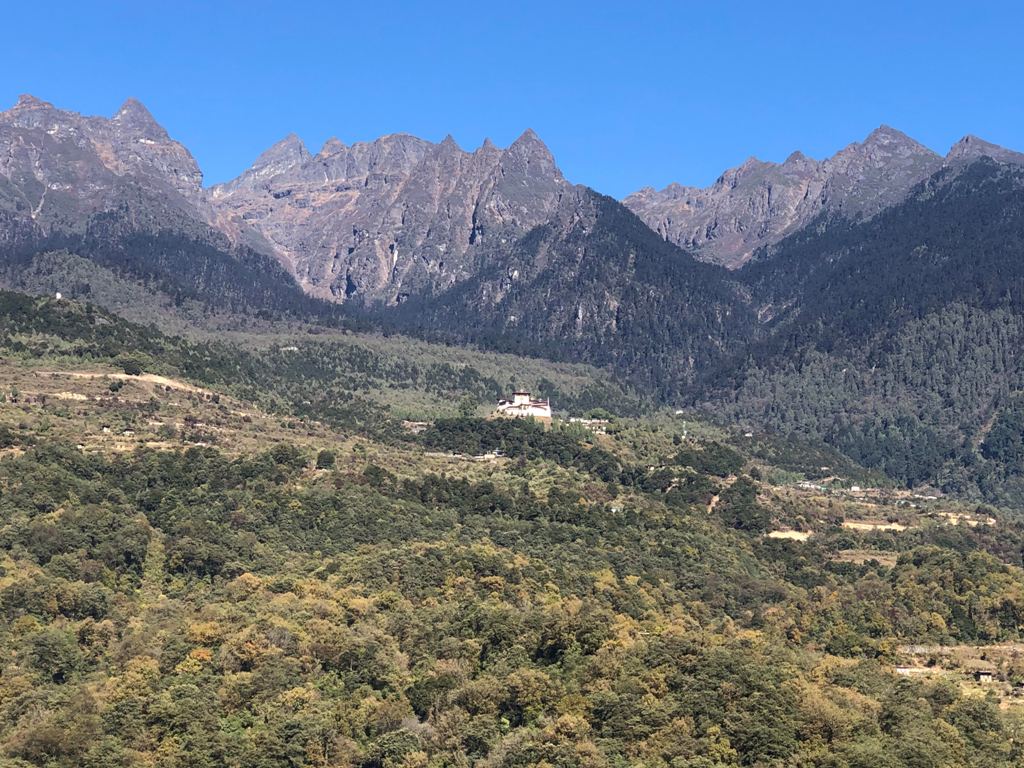
Gasa, literally translating to the land of happiness, is a strategically located northernmost district in the country, safeguarding the nation since time immemorial. The dzongkhag is known for its rich biodiversity and unique culture and tradition: making it one of the best tourist destinations.
Gasa is also famous for its hot springs in the country, frequently visited by thousands of people from all walks of life every year.
The dzongkhag has the most minuscule population, less than 4000 as per NSB, 2017 report. This hindered the development: received less share of the budget allocation through Resource Allocation Formula (RAF) with a population as one of the key criteria representing important development issues and needs of the LGs.
Compared to other dzongkhags, Gasa received the most negligible share of capital grants in the 12th Five Year Plan with only Nu. 665.365 million: Nu. 544.965 M was allocated through RAF and Nu. 120.400 M through CMI.
The multi-dimensional report published by NSB in 2017 indicated that Gasa is likely the poorest dzongkhag (29%) and Haa the next poorest dzongkhag (11%). Moreover, Gasa, Haa, Dagana and Samtse have a higher poverty level than the other 16 dzongkhags.
If the decisions are to be made based on the research and evidence, Gasa deserves the national priority, the government’s attention and the ministry’s support for the development of the district through flagship programs and other sources of funding.
As much as the MPs need to visit their constituency, understand the issues and reality on the ground, it is equally crucial for ministers to visit all dzongkhags, especially those with high poverty and least developed ones.
Gasa dzongkhag was so fortunate to welcome the first-ever female Health Minister, Her Excellency, Lyonpo Dechen Wangmo, as the first minister of the present government to have visited Gasa on April 7, 2019, to observe World Health Day accompanied by a representative from WHO, officials and specialists from the Health Ministry.
Followed by, His Excellency Lyonpo Jai Bir Rai, Education Minister, visit Gasa on September 12, 2019, while on a familiarization tour to schools of Gasa and Punakha.
His Excellency Lyonpo Namgay Tshering, Finance Minister, also visited Gasa on September 19, 2019. His Excellency shared the government’s key focus and rationalization of the government’s expenditure while meeting with dzongkhag officials.
Hon’ble Minister of MoWHS has made a Chopper trip to Lunana Gewog in mid-2019, but there were no official records.
I was less privileged as I could not be there to welcome the ministers. There was a lack of communication from the dzongkhag administration and the ruling MPs. However, I am very grateful for the ministers’ visits and for taking the time to understand the development status of the dzongkhag, work progress, and major issues.
Nevertheless, I had the great pleasure of welcoming the Hon’ble Prime Minister, Hon’ble Chairperson of the National Council and Hon’ble minister of MoWHS to Gasa during the Royal Highland Festival in October 2019.
The Minister of Agriculture and Forests, Hon’ble Lyonpo Yeshey Penjor, recently visited Gasa on April 22, 2020, and met sector heads, regional heads and LG leaders who were present to assess and advise on the preparatory measures undertaken by the dzongkhag relating to assurance and availability of essential items and commercial farming, amongst others.
Unless the minister takes an effort to make an impact where necessary, just a mere official visit and lip service will not suffice. They are the ministers first and representative of their constituency later. If ministers are using their ministerial power to divert the state budgets to fulfil their pledges in their respective constituency by ignoring the most deserving district, they are losing the whole purpose of national vision, and the government’s ideology narrowing the gap between the haves and have not.
Gasa may be small, but Article 12 (1 & 2) of the Constitution guarantees that it has two electoral votes/constituencies for any parties to form the government in the future.
Disclaimer: The views and opinions expressed in this article are those of the authors and do not
necessarily reflect the official position of the National Council of Bhutan.
The covid-19 vaccine gives us hope for the future
- January 3rd, 2021
- 1,634 views

Until an effective vaccine for Covid-19 is ready, effective and well-designed lockdowns with reliable and easily accessible testing methods are the only way forward.
Bhutan experienced nationwide lockdown twice since 11th August last year after a returnee from abroad tested positive outside the quarantine facility. Of late the government enforced the second nationwide lockdown from December 23, 2020, following reports of sporadic cases from flu clinics in Thimphu and Paro. Few cases were also detected in Lhamoizingkha; evidence of local transmission.
However, the recent news of vaccines coming into play gives us hope for the future, only vaccine can end the Covid-19 pandemic. A vaccine for COVID-19 will be a critical tool to bring the pandemic under control, combined with effective testing and preventive measures.
With several promising vaccine candidates in the pipeline, some under review for approval, and the Pfizer/BioNTech and Moderna vaccines approved for use, the race for a safe and effective vaccine has entered a new phase.
There are currently more than 200 vaccine candidates: 56 in clinical and 166 in pre-clinical development. A number of these vaccine candidates are in Phase III clinical trials – the final step before a vaccine is approved.
The two leading vaccine candidates were developed by Moderna Therapeutics, which reported 94.5 percent of efficacy, and Pfizer partnering with the German company BioNTech, showing 95 percent success rate, including 94 percent among those 65 and older.
UNICEF aims to make 2 billion doses of the vaccine available under the COVAX plan by the end of 2021. Under the COVAX plan, the initial doses of vaccines are intended for health workers, social care workers, and people at high risk, such as the elderly or those with underlying conditions.
They are unlikely to be given to children. These populations have been prioritized to help reduce morbidity from COVID-19 and help protect health systems that serve everyone.
Distribution of the Pfizer/BioNTech vaccine is underway in most countries, including the US and UK. India expects to begin vaccinating people against Covid-19 in January this year.
As per the federal health officials of India, around 300 million Indians will be vaccinated between January and early August. It will begin with an estimated 10 million health workers, followed by policemen, soldiers, municipal, and other frontline workers.
India’s drugs regulator today approved Serum Institute’s Oxford’s Covid-19 vaccine Covishield and Bharat Biotech’s Covaxin for restricted emergency use, paving the way for their roll-out soon.
China’s health authorities have approved a Covid-19 vaccine from state-owned Sinopharm for general use on the population and rollout to begin ‘soon’ but about a million have already received injection under emergency approvals.
Bhutan is safe so long as the world is free from Covid-19 and our neighboring giants; India and China are 100% vaccinated and gained herd immunity.
Nevertheless, the Government of Bhutan shared detailed plans to distribute Covid-19 vaccines since September last year. Kuensel reported that the high-risk workers in the healthcare facilities, active front-liners such as police, army personnel, De-Suups, and elderlies above the age of 60 years, and people with comorbidities were considered for the first phase of the distribution.
The second phase is expected to cover passive frontliners – individuals who are in constant contact with the large groups (like media personnel), students, and staff of functional schools and institutions.
Children below 12 years and pregnant women would be included in the third phase while the rest of the population (age 13 to 60 years) residing in the country and who do not fall under any of the above categories would be included in the fourth phase.
As a member of the COVAX facility, Bhutan would receive free vaccines for 20 percent of its population. Meaning, about 150,000 people of the total 756,129 population would be the first recipients of the vaccine.
However, COVAX would deploy the 20 percent in tranches as the first tranche would cover around three percent of the population. The remaining 17 percent would be deployed in the next tranche.
Recently, the Ministry of Health submitted an application to the COVAX facility for vaccine supply, and the first batch of vaccine is expected to dispatch in the first quarter of 2021.
How faster everyone’s lives will return to normal, including society opening and recovery of the economy will depend on the uptake of the vaccine and reach to the herd immunity.
The bottom line is that an effective vaccine will certainly diminish greatly the relative risk of transmission but we still should not completely abandon basic public health measures, including the wearing of masks.
Browse Category
- Gasa Issues (11)
- National Issues (14)
- Personal (3)
- Perspectives (7)
- Speeches (2)



